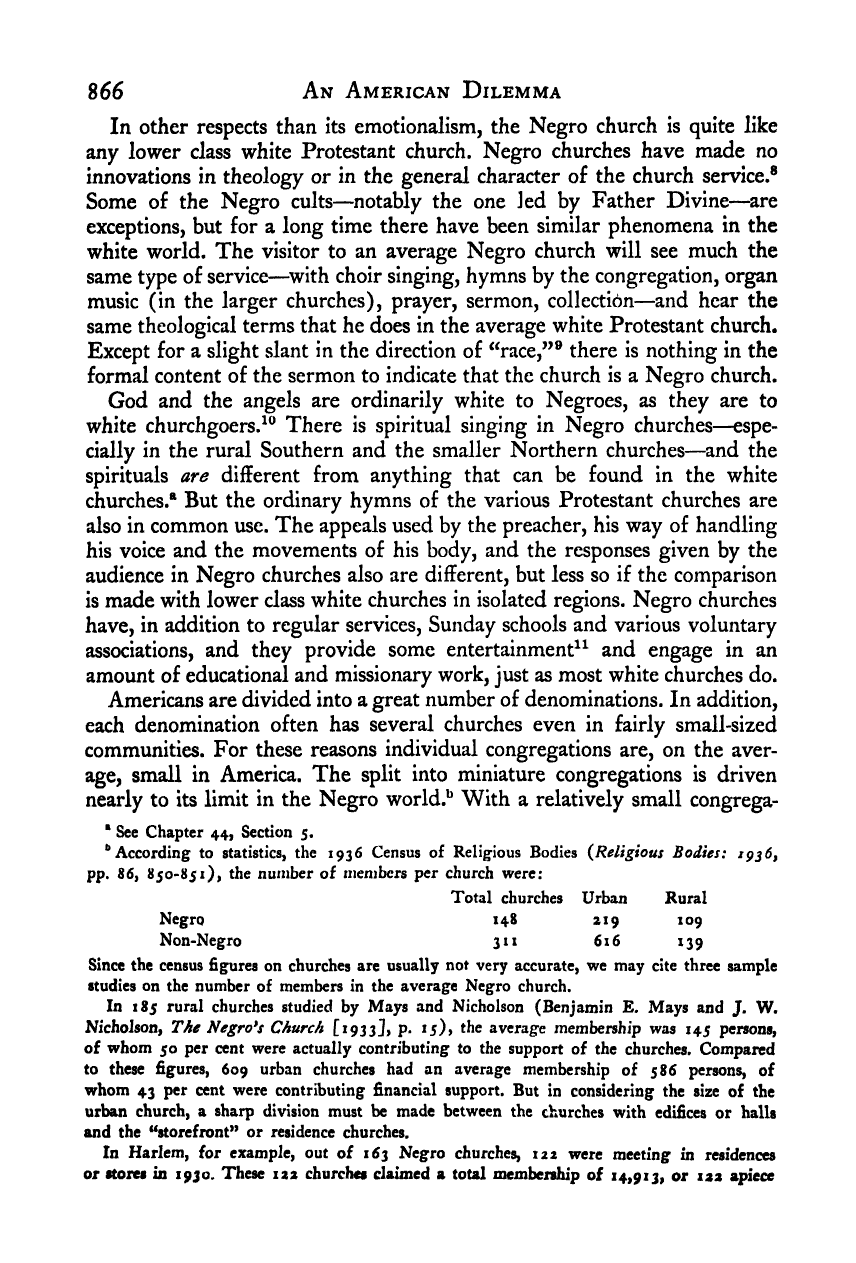Note: Gunnar Myrdal died in 1987, less than 70 years ago. Therefore, this work is protected by copyright, restricting your legal rights to reproduce it. However, you are welcome to view it on screen, as you do now. Read more about copyright.
Full resolution (TIFF) - On this page / på denna sida - IX. Leadership and Concerted Action - 40. The Negro Church - 3. The Negro Church and the General American Pattern of Religious Activity

<< prev. page << föreg. sida << >> nästa sida >> next page >>
Below is the raw OCR text
from the above scanned image.
Do you see an error? Proofread the page now!
Här nedan syns maskintolkade texten från faksimilbilden ovan.
Ser du något fel? Korrekturläs sidan nu!
This page has never been proofread. / Denna sida har aldrig korrekturlästs.
866 An American Dilemma
In other respects than Its emotionalism, the Negro church Is quite like
any lower class white Protestant church. Negro churches have made no
innovations in theology or in the general character of the church service.®
Some of the Negro cults—notably the one Jed by Father Divine—are
exceptions, but for a long time there have been similar phenomena in the
white world. The visitor to an average Negro church will see much the
same type of service—^with choir singing, hymns by the congregation, organ
music (in the larger churches), prayer, sermon, collection—and hear the
same theological terms that he does in the average white Protestant church.
Except for a slight slant in the direction of ^^race,”® there is nothing in the
formal content of the sermon to indicate that the church is a Negro church.
God and the angels are ordinarily white to Negroes, as they are to
white churchgoers.^® There is spiritual singing in Negro churches—espe-
cially in the rural Southern and the smaller Northern churches—and the
spirituals are different from anything that can be found in the white
churches.® But the ordinary hymns of the various Protestant churches are
also in common use. The appeals used by the preacher, his way of handling
his voice and the movements of his body, and the responses given by the
audience in Negro churches also are different, but less so if the comparison
is made with lower class white churches in isolated regions. Negro churches
have, in addition to regular services, Sunday schools and various voluntary
associations, and they provide some entertainment^^ and engage in an
amount of educational and missionary work, just as most white churches do.
Americans are divided into a great number of denominations. In addition,
each denomination often has several churches even in fairly small-sized
communities. For these reasons individual congregations are, on the aver-
age, small in America. The split into miniature congregations is driven
nearly to its limit in the Negro world.® With a relatively small congrega-
* See Chapter 44, Section 5.
**
According to statistics, the 1936 Census of Religious Bodies {Religious Bodies: igs 6,
pp. 86, 850-851), the number of members per church were;
Total churches Urban Rural
Negro 148 2x9 109
Non-Negro 311 616 139
Since the census figures on churches are usually not very accurate, we may cite three sample
studies on the number of members in the average Negro church.
In 185 rural churches studied by Mays and Nicholson (Benjamin E. Mays and J. W.
Nicholson, The Negro’s Church [1933], p. 15), the average membership was 145 persons,
of whom 50 per cent were actually contributing to the support of the churches. Compared
to these figures, 609 urban churches had an average membership of 586 persons, of
whom 43 per cent were contributing financial support. But in considering the size of the
urban church, a sharp division must be made between the churches with edifices or halls
and the “storefront” or residence churches.
In Harlem, for example, out of 163 Negro churches, 122 were meeting in residences
or stores in 1930. These 122 churches claimed a total membership of 14,913, or 122 apiece
<< prev. page << föreg. sida << >> nästa sida >> next page >>